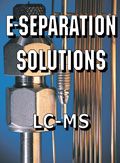Ask the Editor: Applications for Evaporative Light Scattering Detection
Evaporative light scattering detection (ELSD) is considered by many to be a universal detection method for HPLC because its response does not depend on the analyte containing a chromophoric moiety.
A reader recently asked:
What are suitable applications for evaporative light scattering detection?
Evaporative light scattering detection (ELSD) is considered by many to be a universal detection method for HPLC because its response does not depend on the analyte containing a chromophoric moiety. ELSD is able to detect any nonvolatile compound, and the response is related to the size of the analyte particles rather than an extinction coefficient as in light absorbance–based detection.
In ELSD, the column effluent is nebulized, the mobile phase is evaporated in a heated drift tube, and the analytes are passed through a flow cell for exposure to a light beam. The light scattered by the analyte particles is detected by a photomultiplier or photodiode and thereby generates an electrical signal. To achieve the best response, the mobile phase and mobile phase modifiers must be volatile.
Salt buffers are nonvolatile and consequently are not compatible with ELSD. Converting HPLC methods that use nonvolatile mobile phase components for use with ELSD can be a challenging task. ELSD is a good detection choice for analytes lacking a UV chromophore, such as carbohydrates, lipids, surfactants, and fatty acids.
Questions?LCGC technical editor Steve Brown will answer your technical questions. Each month, one question will be selected to appear in this space, so we welcome your submissions. Please send all questions to the attention of "Ask the Editor" at lcgcedit@lcgcmag.com. We look forward to hearing from you.
University of Tasmania Researchers Explore Haloacetic Acid Determiniation in Water with capLC–MS
April 29th 2025Haloacetic acid detection has become important when analyzing drinking and swimming pool water. University of Tasmania researchers have begun applying capillary liquid chromatography as a means of detecting these substances.
Prioritizing Non-Target Screening in LC–HRMS Environmental Sample Analysis
April 28th 2025When analyzing samples using liquid chromatography–high-resolution mass spectrometry, there are various ways the processes can be improved. Researchers created new methods for prioritizing these strategies.

.png&w=3840&q=75)

.png&w=3840&q=75)



.png&w=3840&q=75)



.png&w=3840&q=75)










